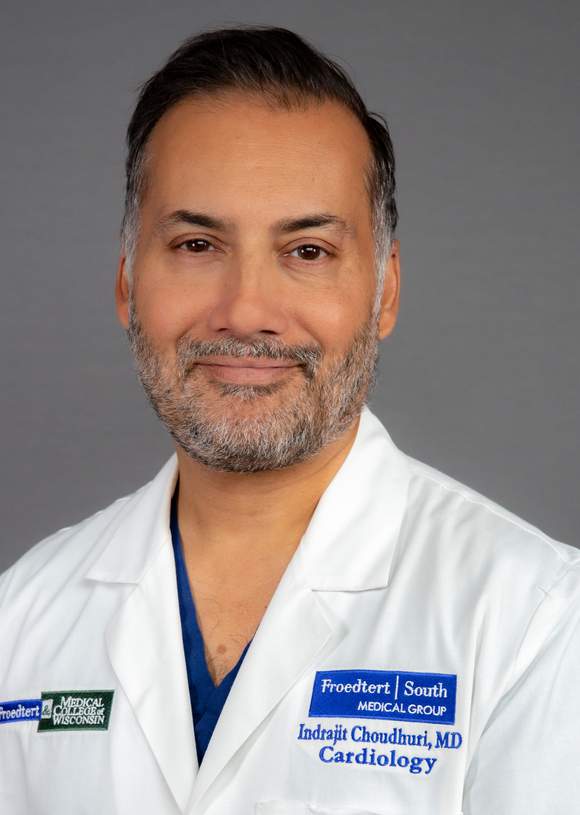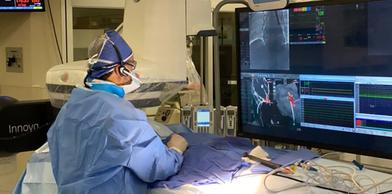About Afib
As an electrophysiologist, I’m essentially an electrical engineer for your heart. My specialty is diagnosing and treating irregular heart rhythms called arrhythmias. Afib – short for atrial fibrillation – is the most common arrhythmia globally. Our multidisciplinary team at the Center for Advanced Arrhythmia Therapies is dedicated to comprehensively managing and supporting patients with Afib at Froedtert Pleasant Prairie Hospital.
Afib causes the upper chambers of the heart to quiver rather than squeeze and contract normally. This reduces the volume of blood pumped to the rest of the body and causes symptoms such a fluttering or “flip flopping” in your chest, tachycardia or rapid heart rate, palpitations, and can cause you to feel out of breath, fatigued, dizzy and weak even to the point of fainting, often with an uneasy feeling that your heart is not working well. It can be terrifying for patients, and yet many patients experience no symptoms at all. In fact, this can be even more dangerous because they may not realize that they are at risk for complications related to Afib, such as stroke and heart failure.

Indrajit Choudhuri, M.D. Electrophysiologist at Froedtert Pleasant Prairie Hospital
Teaming up on patients
At Froedtert Pleasant Prairie Hospital, Afib care is managed by a team: cardiac surgeons, interventional cardiologists, an electrophysiologist (me), along with weight management and sleep apnea specialists all working together to improve outcomes for Afib patients.
This advanced and holistic approach to Afib is uncommon at community hospitals like ours, and more typically seen at large medical centers in major cities. What we're providing at Froedtert Pleasant Prairie Hospital means Afib patients in the Kenosha County and northern Illinois communities we serve can get advanced care for Afib right here, close to home.
Managing risks and results
When we see a patient who has Afib for the first time, we want to know why they developed the irregular heart rhythm. For example, if obesity played a role, we may involve a weight management specialist to develop a weight loss program with the patient. If sleep apnea contributed, we may turn to a sleep specialist to make that diagnosis and recommend treatment options. Other risk factors such as high blood pressure, excessive alcohol consumption, or smoking may need to be addressed as well.
Our objective with each Afib patient is to help them achieve their goals. We present patients several options, which may include lifestyle changes that help them with weight loss, reducing alcohol and nicotine dependence, and managing other factors that can cause or contribute to Afib. We also help patients decide how they want to manage their Afib directly. With some patients, that means allowing their heart to stay in its irregular rhythm, while controlling their heart rate. With other patients, it involves taking steps to get their heart back into a normal rhythm.
Leading edge diagnostic tools
Critical to the success of our Afib program is a new technology that translates a traditional 12-lead electrocardiogram – more commonly known as an EKG – into a three-dimensional map that shows where in the heart the patient’s abnormal beats are coming from. It only takes minutes to produce the map, but it helps us precisely plan the procedure we need to perform to stop the Afib. It also gives our team and patients confidence that we’ve identified the problem areas so we can effectively treat them.
I recently established care with a patient who suffered with AFib and other abnormal heartbeats for years. She had undergone three ablations – a catheter-based procedure performed through the veins to modify the heart tissue and prevent electrical impulses from triggering arrhythmias - at an outside institution to help eliminate two different types of arrhythmias, including Afib. Within a short period of time, her arrhythmias had returned. Based on this experience, she had decided not to have any more procedures done, and she would simply live with her debilitating symptoms. When I met her, she was hospitalized with congestive heart failure as a complication of her Afib.
Using our new technology, I converted her routine hospital EKG into a 3D map. I told her the map revealed specific areas in her heart that were maintaining Afib and that we would target these areas as part of a comprehensive ablation strategy to control Afib. When I showed her the map her eyebrows shot up in surprise, her jaw dropped, and she smiled from ear to ear. She told me she thought we should give ablation one more try. For nearly a year, she has had no recurrence of any arrhythmias, including Afib. That demonstrates the power of showing patients what's actually going on with their heart, and how what we’re recommending is tailored to their specific needs to deliver an effective treatment strategy. This is personalized medicine.
Preventing strokes
One of our primary objectives in treating Afib is stroke prevention. Afib allows blood to stagnate in the upper chambers of the heart where it can form blood clots. Previously, blood thinners were the only solution, but those medications prevent blood clots everywhere in the body. Patients who take them may have significant bleeding from even minor cuts and scratches, nose bleeds, or bruises. Patients can end up in an emergency room because they're on blood thinners.
We now have a new treatment available at Froedtert Pleasant Prairie Hospital called left atrial appendage closure – sometimes called “the Watchman” procedure – that prevents blood clots without requiring patients to be on blood thinners.
Some ninety-five percent of the blood clots that cause strokes in Afib patients are formed in what’s called a left atrial appendage of the heart – an outpouching, or small protrusion in the inner lining of the heart that collects blood. The outpouching can be easily closed off with a little plug or umbrella delivered to the right spot with a simple catheter-based procedure, preventing blood from pooling and forming clots.
Remotely monitoring patients
As part of our multidisciplinary Afib approach, we’ve dramatically expanded our remote monitoring capability using the MediCardia Advanced Remote Monitoring System. When we’re working with a patient to help manage their weight or sleep apnea, our monitoring system sends us data right from their home. We can even monitor a patient’s EKGs from home, enabling us to see how their AFib is responding to treatment. We’re better able to track a patient’s progress and, if warranted, recommend lifestyle or medication changes without having them come into the office. Patients love that, because it means they don't have to take time off from work, or arrange transportation, or otherwise interrupt their day for a fairly brief doctor’s office visit. The MediCardia system also uses a mobile app that allows patients to see their blood pressure, weight, and heart rhythm, so they can be involved in their treatment program and progress. In addition, by not requiring every Afib patient to come to our office for routine monitoring, we’re able to reduce wait times for new patients who are eager to see us.
Advanced care for patients
On a patient-by-patient basis, I see how our collaborative approach with the advanced diagnostic tools, medicines, procedures, and remote monitoring we’re using is dramatically improving patients’ lives. I feel really good about that.
Patients are very appreciative of the care that we're giving them. Our multidisciplinary approach to Afib is not only worth the time and effort, it’s also so gratifying and fulfilling for me and our entire team at Froedtert Pleasant Prairie Hospital to see the impact we’re having on patients.
The opportunity to provide this care to our community is a gift, as well as a responsibility to do the very best we can every day for the patients we serve. That’s how we look at it.
Afib by the numbers
- In 2023, Afib affected six million people in the U.S.
- That number is projected to rise to more than twelve million people by 2030
- One in four people over the age of forty are at risk of developing Afib
- Symptoms may include:
- Irregular heartbeat
- Heart palpitations (rapid, fluttering, or pounding)
- Lightheadedness
- Extreme fatigue
- Shortness of breath
- Chest pain


